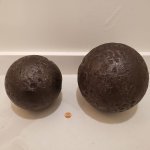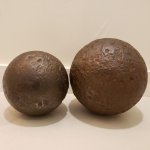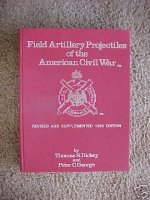ericmpaulson
Tenderfoot
I need help authenticating what appears to be two cannon balls I found while gardening in Westchester County NY.
Below is a description of what I found:
Ball #1:
31 pounds
6.13 inches diameter
19.63 inches circumference
Ball #2:
61.8 pounds
7.88 inches diameter
24.5 inches circumference
They were heavily rusted when I found them. I spent several hours cleaning them up with a wire brush and steel wool. They are both solid shot and definitely do not contain any explosives.
According to the research I've done thus far, 32 pound cannonballs were a standard size that were produced by the British during the Revolutionary War period. From what I understand, these cannon balls were sometimes a few pounds shy of their designated weight. As for the larger ball I found, its weight of 61.8 pounds may indicate that it was made for a 64 pound cannon, maybe? The diameters seem to be an almost exact match to the production size of each.
If these are in fact cannonballs, I may be interested in selling one of them, and I was wondering what the value may be on them?
Below is a web link that I came across in my research which lists the common sizes of larger cannon balls. The figures seem to correlate. I figured I'd attach it here so that you can take a look:
Cannon bore, shot, and shell diameters for smoothbore guns
This is my first post on this forum, so I thank you all in advance for your help.

Below is a description of what I found:
Ball #1:
31 pounds
6.13 inches diameter
19.63 inches circumference
Ball #2:
61.8 pounds
7.88 inches diameter
24.5 inches circumference
They were heavily rusted when I found them. I spent several hours cleaning them up with a wire brush and steel wool. They are both solid shot and definitely do not contain any explosives.
According to the research I've done thus far, 32 pound cannonballs were a standard size that were produced by the British during the Revolutionary War period. From what I understand, these cannon balls were sometimes a few pounds shy of their designated weight. As for the larger ball I found, its weight of 61.8 pounds may indicate that it was made for a 64 pound cannon, maybe? The diameters seem to be an almost exact match to the production size of each.
If these are in fact cannonballs, I may be interested in selling one of them, and I was wondering what the value may be on them?
Below is a web link that I came across in my research which lists the common sizes of larger cannon balls. The figures seem to correlate. I figured I'd attach it here so that you can take a look:
Cannon bore, shot, and shell diameters for smoothbore guns
This is my first post on this forum, so I thank you all in advance for your help.

Amazon Forum Fav 👍
Attachments
Last edited:
Upvote
15










